Robots are really, really good at games. They’re not so great at doing everyday things, like holding a conversation, but give them a set of defined, concrete rules, and they will work to devise a perfect solution to any problem in a matter of hours.
Neural networks allow robots to create rules for problems which don’t have any; things that humans just intuitively know. When we look at a picture of a car, we just know that it’s a car. We don’t quantify the RGB values present in each pixel and group them into sections to determine that it’s a car.
This is what is called, in computer science, a “hidden” layer: a set of rules a computer creates for itself in order to accomplish a task. Neural networks all have at least one hidden layer, but any with two or more are called “deep” neural networks, or DNNs. The more hidden layers the computer generates, the more reliably it can solve complex problems, like image identification. The deeper the network is, however, the less we know about how the computer has generated its solution.
Last Friday, Nov. 30, Christopher Healey, a professor of computer science at NC State, talked for an hour about DNNs at Hunt Library on Centennial campus in the teaching and visualization lab, as part of its free and open Coffee & Viz series. He demonstrated how DNNs can be used for dozens of different applications, like filling in missing portions of an image, analyzing texts to find parts of speech and of course, winning at games.
Shaoliang Nie, a Ph.D. student studying computer science, contributed to the research which inspired the event, and was one of over 40 attendees present.
“Even though [DNNs are] very popular and powerful, we really don’t understand what’s going on inside,” Nie said. “Visualization can help us see what is happening… and that can help us have a good understanding of what connects these ends, so we can use them with more confidence and try to think of our original problem with a different perspective.”
Healey presented a number of different visualizations at the event which demonstrated how computers think in unconventional ways. For example, although one neural network could reliably identify adverbs in a sentence, it took vastly different paths through its many hidden layers to pick out each one.
So far, it seems like these machines can be good at anything with enough practice. However, Healey stressed that they probably won’t be taking over the world anytime soon.
“Deep networks are about five or six years old, in terms of that terminology and people becoming aware of them,” Healey said. “So at this point, people are still exploring, ‘what can I do with a deep learning system?’ because it’s had such great success in these areas, like image identification, image classification or areas like text analytics. But we’re not really sure yet, and I think one of the purposes of the talk was to say it’s probably not going to be good for everything. So, if you think it’s potentially useful, definitely try it out, but don’t be disappointed if it turns out that’s really not the thing that you’re looking for.”
Farida Akhtari, a Ph.D. student studying genetics and statistics, said she appreciated the blend of simplified concepts and detailed explanation at Healey’s talk.
“I’ve been very interested in machine learning and A.I.,” Akhtari said. “I’ve taken one or two classes and attended some other talks put on at the library. The depth sometimes varies, and it depends on the presenters and what they’re talking about, but I thought today was just perfect. He talked about the applications, which was more high level, and then he did go into some of the mathematical details as well, so I think he made everybody happy. I like that mix. And it was a one-hour talk, so it was a limited amount of time, but I thought he presented really well and the slides were beautiful.”
Walt Gurley, a data & visualization librarian at Hunt, is a member of the Coffee & Viz team, which coordinated the event. He said that while DNNs are relatively new and somewhat mysterious, students can still freely work with them using NC State’s powerful computing resources.
“Trying to bring these topics to a general audience, [Healey] did a great job with demonstrating that there are libraries out here that you could do this yourself,” Gurley said. “So, trying to introduce these topical concepts to a broader audience, in hopes that we’ll maybe enlighten someone on how they could do something new, but even try to do these cross-collaboration opportunities. Coffee & Viz does serve, on top of just one event, to really bring different audiences together.”
Though this was the last Coffee & Viz event for this semester, the team disclosed that they have five events planned for next semester so far. Three of them will be conducted by members of NC State faculty, and the other two by outside speakers, including their first ever talk on data sonification. Information for upcoming events will be available shortly on the Coffee & Viz website.













